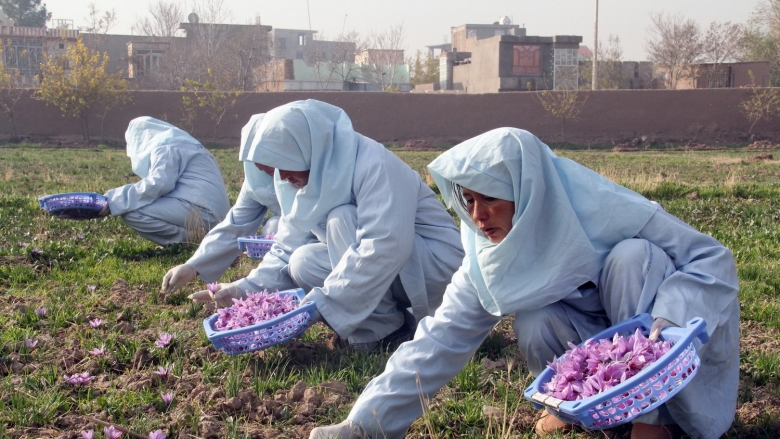Results
At a total cost of US$45.23 million, AREDP developed micro-enterprises at village level and supported SMEs to create supply chains from 2010 to 2018 and achieved the following:
- The project mobilized 81,880 rural men and women to establish 7,239 Savings Groups (SGs) (52 percent women), 1,768 Enterprise Groups (EGs) (65% managed by women) and 536 Village Savings and Loan Associations (VSLAs).
- The SGs saved a total of Afs378 million or US$5.2 million which was made available as credit to start up village-level enterprises in agriculture, livestock, food processing, handicrafts, and carpets. The project is financially inclusive of women, disabled, and nomads (Kuchis).
- As of June 2018, the project has gross loan portfolio of Afs1.1 billion or US$14 million with 80% of loanable funds in circulation and repayment rate as high as 95%. The project provided financial and non-financial services to 18% of the country’s active microfinance borrowers and had 6% of the sector’s gross loan portfolio. Almost 60% of borrowers were women.
- AREDP aggregated 349 matured EGs into 60 producer associations (PAs) to facilitate linkages with the 800 SMEs which were promoted. 20% of SMEs were women owned.
- The EG formation and development were supported by the Business Development Service Providers (BDSPs), through “deliverables-based payment” approach which reduced cost of operation by almost 20%.
- EG’s annual sales increased from Afs7.5 million or US$102,000 to Afs230 million or US$3.2 million. Furthermore, 86% of EGs increased their net revenues by over 20%. On the average, EGs’ increase in net revenues was about 47%.
- The SMEs also had an increase in annual sales by about 20%, from Afs918 million or US$12.6 million in 2015 to Afs1.1 billion or US$15 million in 2017.
- In about eight years, 37% of EGs and SMEs increased direct employment by at least 30%. The project has created a total of 8,155 and 13,918 new jobs.
Bank Group Contribution
IDA has played an important role in assisting reconstruction and development in Afghanistan. The AREDP is one of the instruments that IDA used to implement its support to the reconstruction and development of Afghanistan. The project cost was USD 45.23 million for eight years in five provinces of Afghanistan. The IDA grant was USD$30 million while USD$15 million was provided by the Afghanistan Reconstruction Trust Fund (ARTF) which is funded by 34 donors and administered by the World Bank.
Partners
The Project was implemented by the Ministry of Rural Rehabilitation and Development (MRRD) in five provinces of Afghanistan (i.e., Balkh, Bamyan, Herat, Nangahar, and Parwan). At the village level, it partnered with middlemen and traders to support rural producers in sustainable supply chains. The project also links up with SMEs in growth centers to strengthen enterprise management, product quality, and value addition. AREDP federates mature Saving Groups (SGs) into Village Saving and Loan Associations (VSLAs) that are eventually linked to the Microfinance Institutions (MFIs) for credit support. The job trainings are carried out through collaboration with local and international NGOs, development partners and learning institutions in Afghanistan. Through exhibitions and trade fairs that are frequently promoted by the project, forward linkages with inclusion of contracts were also made between rural producers, urban sellers, distributors and governmental institutions.
Moving Forward
The project provided for in-built mechanisms to ensure the sustainability of its community groups and its business continuity. It does this through its self-help based indigenous microfinance model with no matching grant, which has created a sense of ownership and developed confidence among beneficiaries. The hiring of SMEs as BDSPs, the linkage with government institutions and collaboration with service providers ensured uninterrupted self-propelled chain of business development. The project has now been transformed into a national project of USD$100 million that focuses on women enterprise. The new project called Women Economic Empowerment Rural Development Project (WEE-RDP) covers the whole 34 provinces and modeled after AREDP.
Beneficiaries
Mohammad Naim is a saffron farmer in Herat province. In 2013, Naim, with support from the Afghanistan Rural Enterprise Development Project (AREDP), established Taban Enterprise Group. He and the Group members participated in training, exposure visits, and agriculture fairs nationwide. The Group has since improved their saffron quality and expanded their operation to seasonally hire 120 women for harvesting and processing. “I was just a small-scale enterprise owner,” said Naim, “but after AREDP supported me, I have become a nation-wide entrepreneur. From not being able to cover my own family expenses to an annual income of Afs 400,000 (about US$6,000) is a dream come true, and I have AREDP to thank for making this happen.”
